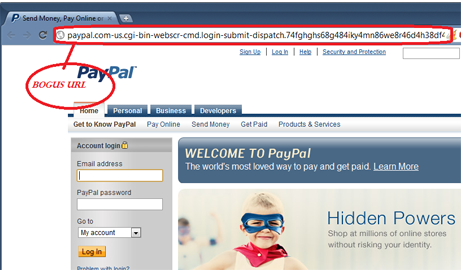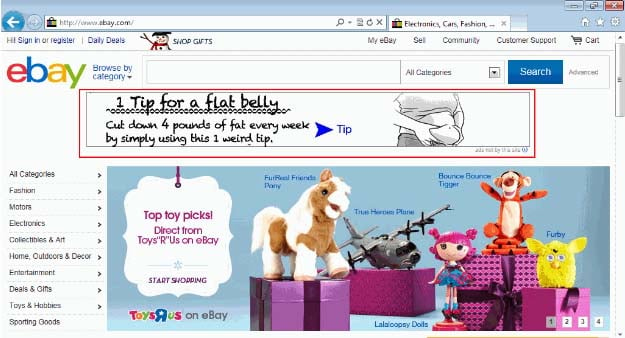Every year, advertisers lose billions to ad fraud, and there are many brand and agency professionals who don’t even realize it. In fact, as many as 37% of advertisers are unaware of ad fraud or how it’s affected their marketing efforts.
8 Ad Fraud Techniques and How to Stop Them
If you don’t know what to look for, detecting ad fraud is next to impossible. But the more you know about it, the better you’ll be able to protect yourself and your advertising budget. Here are eight deadly types of ad fraud techniques that you need to be aware of.
URL/Domain Spoofing
It can be tricky to spot domain/URL spoofing, and it only takes one line of code for you to become a victim.
Fraudsters will use this line of code to change the website address of their site to mimic the URL of a more reputable site. At first glance, it looks like the fraudster’s site is actually the real one. So, when you land on a spoofed site, you think you’re visiting a reputable publisher (such as PayPal).

Source: Wikipedia
But, if you log into a spoofed website and type in any personal information, you’re giving fraudsters exactly what they want: sensitive information about your finances.
Another popular tactic fraudsters use is selling advertising on a spoofed site at a lesser price, so it looks like you’re getting a discount on premium ad space. Unfortunately, you’re not, and your ad will probably end up somewhere questionable and potentially harmful to your brand image, such as a porn or piracy site.
Lead Generation Fraud
Lead generation fraud is caused by both bots and their human counterparts.
When fraudulent traffic is from humans, it usually occurs when publishers purchase traffic for their site. You’ve probably seen “work from home” schemes, a lot of them involve hiring people to interact with these shady publishers to bump up their traffic numbers.
This is a problem for advertisers because they pay to place ads on a site that seems to get good traffic, and it even looks like they’re generating leads, but these “leads” will never convert.
Even social media advertising isn’t immune to lead fraud. There are businesses called click farms that are based around selling likes and shares to fake social media profiles. These bogus profiles will interact with anything—including your paid social media ads— and fraudulently chip away at your advertising budget.
Lead fraud from bot traffic has become a larger problem in the past few years because bots are getting more advanced, and therefore more difficult to detect.
Bots can easily generate ad impressions and fill out forms by mimicking human movements. They can trick advertisers into thinking they’ve gained a new lead’s contact information, when it was really just a bot. The new lead's information is either stolen or aged data that is used by the bot to fill out these forms, a practice which opens advertisers up to TCPA violations, problems with brand security, and wasted ad spend.
Traffic Fraud
Traffic fraud is similar to lead fraud, but this type of fraud targets the publishers as victims. To increase their traffic numbers, some publishers will purchase additional traffic so they can ultimately charge more for advertising.
Unfortunately, most purchased traffic comes from unreliable third-party sites, which are generally crawling with bot traffic. This means that publishers are paying for illegitimate traffic, even if they don’t realize it, then charging a premium price for advertising on their site, even though they don’t actually have legitimate traffic to offer. This can destroy their reputation as a publisher for future advertisers and lead to a loss of revenue over time.
Retargeting Fraud
Retargeting fraud involves bots similar to the ones involved with lead fraud. Fraudsters program the bots to act exactly like humans to interact with ads to trigger retargeting campaigns.
Once again, advertisers are spending money to continue advertising to users they believe are real customers. In fact, they might even increase their retargeting budget because they think they're getting a flood of new customers who are on the verge of converting. Sadly, although bots can click these retargeting ads and appear to be potential customers, these leads will never convert and only open publishers up to the potential of more bad traffic and potential TCPA violations.
Injected Ads
Ad injection involves a type of malware that infects a web page and makes it vulnerable to unwanted ads randomly appearing on the site. Even some of the biggest brands in the world have fallen victim to ad injection.

Source: Ben Edelman
When an ad is injected onto a site by a fraudster, that ad space is never actually purchased and does not generate any revenue. Most of the time, these ads will either be inappropriate for the site they’re on (which can hurt your brand’s reputation) or, will often redirect anyone that engages with them to questionable sites, or a competitor's site, such as Target’s ad on Walmart’s website.

Source: Advertising Age
Not only do injected ads leave a site’s brand reputation at risk, but they can also slow down the site speed for consumers.
The practice of unwanted, injected ads almost always devalues the targeted site for any future advertisements. Seasoned marketers will not knowingly risk losing money by advertising on a less reputable site or a site that has been targeted by injected ads.
Affiliate Ad Fraud
Affiliate marketing is a popular performance-based marketing strategy where individuals or businesses earn commissions by promoting products or services of other brands or companies. Individual affiliates drive traffic and product sales through referral links, and when a purchase is made, they receive a commission or a small percentage of each sale. Affiliate ad fraud targets the commissions those affiliates receive.
One type of Affiliate ad fraud is known as “cookie stuffing.” Usually, an affiliate gets paid when they drive consumers to the company’s website and that consumer makes a purchase. Often, fraudsters will install a cookie on the consumer's browser and then proceed to track that traffic. Then, if a tracked consumer makes a purchase, the fraudsters will drain part or all of the affiliate’s commission into their own pockets. This practice often goes on unnoticed resulting in millions of dollars being lost by legitimate affiliates.
Ad Stacking and Pixel Stuffing
Ad stacking and pixel stuffing are both types of impression-based fraud. Basically, advertisers think they are paying for their ads to be seen by potential customers, but impression-based fraud does not deliver ads to actual viewers.
![]()
Source: LinkedIn
Ad stacking involves literally stacking ads on top of each other in a web page. Only the top ad is ever seen by the consumer, even though an impression is counted for each ad on the page. It’s one of the more subtle types of ad fraud, because it’s difficult to tell that there are additional ads hidden underneath.
Similarly, pixel stuffing involves counting an impression when the ads virtually impossible to see. But instead of stacking them, entire ads are “stuffed” into tiny individual pixels.
Technically, the ads are there when the page loads, but they are essentially invisible.
Any type of ad can be minimized into a pixel, including a video ad. If you’ve ever visited a web page and heard audio playing, but couldn’t find a video to accompany it, you’ve most likely come across an example of pixel stuffing.
Search Ad Fraud
Search ad fraud is one of the most common forms of fraud resulting in advertisers losing money.
Fraudsters develop fake websites that target expensive keywords in order to look like reputable publishers to potential advertisers. Then, they’ll sell ad space on these fraudulent sites targeting the popular keywords (that also come with a high CPC).
The site owner will then use bots or human click farms to engage with the ads, which benefits the site owner because they’re generating revenue. This practice costs the advertisers big time and drains budgets without ever serving the ads to a single qualified lead. The targeted advertisers continue to pay a premium price for space on a website that was never actually going to reach actual people or get them any legitimate clicks.
Preventative Measures
These ad fraud techniques can be difficult to monitor and catch without the right tools. But you can take a few measures to help protect yourself.
It’s always a good idea to request transparency from your publishers. Ask them where their traffic originates. A trustworthy publisher will be able to tell you, and if they don’t, you might want to avoid them.
You can search for your site with your browser in incognito mode. Doing this will let you see what pops up on your site to any newcomers or other users.
You can also use a third-party monitoring system to filter your incoming traffic. It’s especially helpful to find a service that monitors traffic in real-time, so you can stop any fraudulent traffic before it costs you money.
Way too much of marketers’ ad budgets are being lost to fraud. It’s essential that you know what types of ad fraud are lurking out there so you can be better prepared to stop it. Schedule a trial with the Anura team to learn how an ad fraud detection platform can improve your campaign performance.


